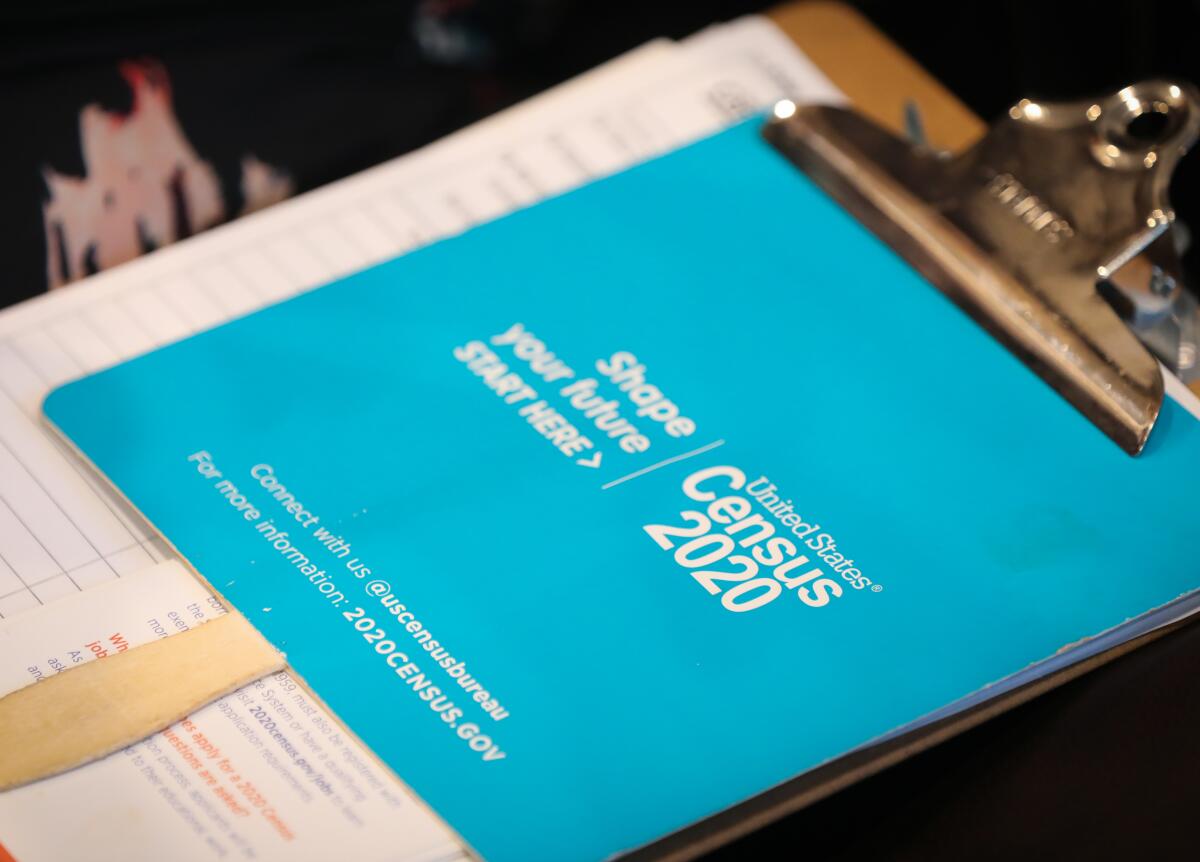Coronavirus makes California census count more crucial, and more challenging

- Share via
Taking a head count of the entire U.S. population was already going to be hard. The coronavirus will make it much harder.
Across California, grassroots groups looking to amp up census participation among historically hard-to-count communities have hit a snag: how to reach people at a time when many are self-quarantining to stem the spread of the pandemic.
Canvassers had hoped to use the weeks leading up to Census Day, April 1, to reach communities that are at the greatest risk of an undercount by knocking on doors. They were betting that a face-to-face connection would help to ensure Californians would fill out the decennial survey.
But with social distancing, those conversations will have to happen via text messages and phone calls, or on social media.
“With increased restrictions on group gatherings, we’re seeing we may not even be able to convene folks on-site to do collective phone banking,” said Kevin Cosney, senior organizing manager at California Calls, a coalition of community groups. “We were supposed to launch our outreach efforts last weekend. Now we won’t be able to until at least April.”
California Calls aims to provide workers with the resources needed to do their phone banking remotely, he said.
On Wednesday, the U.S. Census Bureau announced it would temporarily suspend all field operations for the 2020 census for two weeks, until April 1, to help slow the virus.
Steven Dillingham, the bureau’s director, said the office is making the change “to help protect the health and safety of the American public, Census Bureau employees, and everyone going through the hiring process for temporary census taker positions.”
Even before the outbreak, officials said that Los Angeles County would be the nation’s hardest to tally because of its high concentrations of renters and homeless people, as well as immigrant communities that may not participate because of language barriers or because they fear reprisal from the federal government.
States draw on census data to form school district boundaries, and many of the services that people rely on in California — such as nutrition programs and housing assistance — are tied to funds calculated using the census. Statewide, 72% of the population belongs to one or another historically undercounted group.
Cosney worries that organizations such as his could lose out on connecting with people who aren’t registered to vote, whose phone numbers they wouldn’t have, or ethnic communities that would respond well to a conversation with a “trusted messenger.”
The point of outreach on the streets, he added, was to tell people the various ways they could ensure they were counted, whether through online participation, calling in their responses or going to an assistance center.
Their focus now is not only on participation rates, but also on pivoting their messaging to underscore the importance of vulnerable populations, such as California’s tens of thousands of homeless people, being counted.
“It’s hard to do social distancing if you don’t have a home,” Cosney said. “And one way to ensure affordable housing is by completing the census. It’s hard to stay healthy if we don’t have adequate healthcare services. Certainly, the census is a way to ensure that.”
William Frey, a demographer and senior fellow at the Brookings Institution, said hard-to-count groups are “the exact communities that may require face-to-face interaction.”
A widespread illness such as the coronavirus, he added, is the “kind of situation where people need to be able to rely on the government to have good information on where people who are vulnerable live.”
“This is one of the reasons we take the census,” he said. “It’s the basis for these government and private sector programs that help vulnerable populations in a time like this.”
Both the census bureau and the state have encouraged people to complete the survey online or by phone. More than 11 million people already have responded to the 2020 census, according to the Census Bureau.
In an email, a spokesperson for the bureau noted the importance of self-responding online to avoid the in-person nonresponse follow-up by a census taker.
“We are working with our partners in local, county and state governments to make sure people are informed that their census invitation will be at their homes by March 20th and that it is imperative, given the current health emergency, that people follow suit by filling out their survey,” the spokesperson said.
The closure or quarantining of many homeless shelters, nursing homes and colleges because of the virus is also forcing the bureau to change the way it counts some of the most-difficult-to-reach populations. The move might mean that the count could take longer.
The original plan was to have census workers interview each person staying at an emergency or transitional shelter, or eating at a soup kitchen or mobile food vans between March 30 and April 1.
Rather than starting March 30, the bureau will delay its mobile outreach, which is often set up at grocery stores, churches or festivals in areas with low response rates. The bureau has also decided to push the start of census takers’ door-knocking in college towns to April 23.
This is one of the reasons we take the census. It’s the basis for these government and private sector programs that help vulnerable populations in a time like this.
— William Frey, demographer
As the bureau makes those changes, groups are also looking at how best to tailor their online messaging.
“Some partners have started to use online contests to boost social media outreach,” said June Lim, demographic research project director at Asian Americans Advancing Justice.
One of AAAJ’s community partners in the Fresno area has encouraged its young, college-age residents to create bilingual YouTube videos related to the census in various Southeast Asian languages and in English, Lim said. A Pacific Islander group, she added, is encouraging people to post videos or photos of themselves with a completed form with the hashtag #mystoryhasbeenwritten.
“Before, the messaging was about safety related to confidentiality,” Lim said. “Now, I think it’s not just going to be that, but also safety in terms of you can do it without leaving your home, without compromising your health or the health of others.”
Like other groups, AAAJ plans on increasing its phone banking efforts, she said.
Arturo Vargas, chief executive of NALEO Educational Fund, said that the organization’s public outreach has also shifted to social media. Their messaging, he said, is encouraging people to self-respond because it is a “great way to avoid someone coming and knocking on your door.” They are also noting that census data is critical to planning and the allocation of resources during a crisis.
“I would imagine governments are looking at data updated by the Census Bureau to make plans for providing supplies and enough food and other items for their populations,” he said. “Under the current situation, the elderly population is vulnerable. Under census data, you have information on age groups.”
NALEO is reminding people that they can call in their response to the census as well, he said.
“Anybody who is marginalized in society in any way,” he said, “by poverty, by language, by housing situation — I think this [virus] exponentially complicates ability to count those populations.”
Times staff writer Sarah D. Wire contributed to this report.
More to Read
Sign up for Essential California
The most important California stories and recommendations in your inbox every morning.
You may occasionally receive promotional content from the Los Angeles Times.










